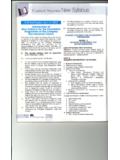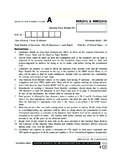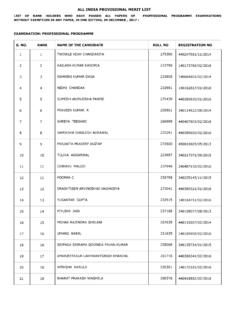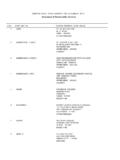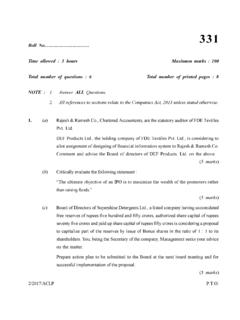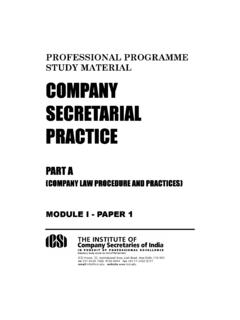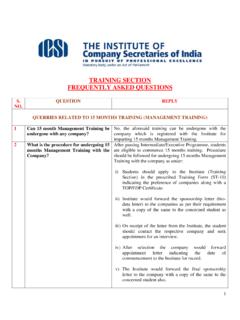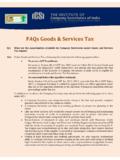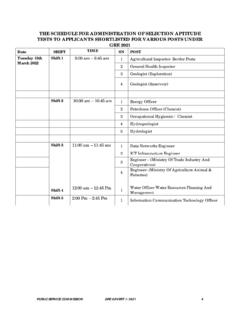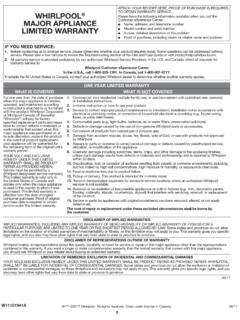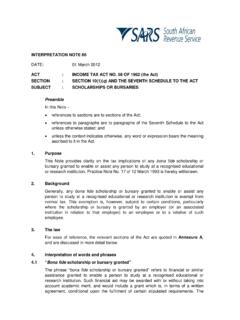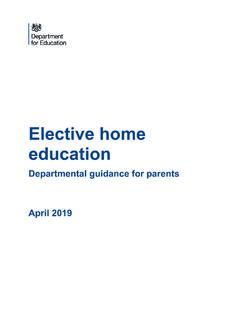Transcription of LEGAL APTITUDE AND LOGICAL REASONING - ICSI
1 BUSINESSCOMMUNICATIONL esson1 English Grammar andits Usage12 Enriching Vocabulary263 Comprehension of Passageand Art of Summarising564 Concept of Business Communication765 Listening Skills1016 Business Correspondence1157 Concept of E-Correspondence1408 Common Business Terminologies155 Disclaimer :Although due care and diligence have been taken in preparation of this reference reading material, theInstitute shall not be responsible for any loss or damage, resulting from any action taken on the basis of the contents of thismaterial. Anyone wishing to act on the basis of the material contained herein should do so after cross checking with theoriginal 2022 Lesson 1 ENGLISH GRAMMARAND ITS USAGE1 Business Communication2 GRAMMAR AND ITS USAGEE nglish language follows a set of rules like all other languages. Broadly speaking, the part of Grammarconcerned with changes in the form of words by internal modification or by affixation is known as accidenceand the manner in which these words are arranged in the form of a sentence is called syntax.
2 For example,the root word contradiction is a noun. It can be changed into different parts of speech. If you say contradict,it becomes a verb and if you say contradictory it becomes an dictionaries give all the changes that a root word can to Know!!!Some words may be used as different parts of speech without any change in their example, the word beat remains unchanged in the following sentences; though it is adifferent part of speech in each sentence : The angry mob was beating the thief mercilessly. (verb). The beat of the drum sent people into frenzy (noun) The beat generation (young people with unconventional dress and behaviour as anexpression of social philosophy) has its own ethics. (Adjective)Sometimes it is possible to use the same word, with a slight modification, as a different partof speech:For example, the root word confirm is used here as a noun in the first, as a verb in thesecond and as an adjective in the third sentence. We received confirmation of the order in writing yesterday.
3 (Noun) The party confirmed the receipt of the consignment. (Verb) He is a confirmed defaulter. (Adjective)Parts of Speech in EnglishWords are divided into eight classes according to the work they do in a sentence. They are as follows:PARTS OF SPEECH Noun Pronoun Adjectives Verbs Adverbs Prepositions Conjunctions InterjectionsBusiness Communication3 These word classes are called Part of are explained below:NounsA noun is a naming word . It names somebody or took the dog to the car makes a lot of at the example above. A noun is a name of a person (Rahul), animal (dog), place (park), thing(car) or idea (noise).Kinds of NounsNouns may be divided into (a) common nouns and (b) proper nouns are the names given in common to all persons, places or things of the same class. Forexample, bank, shop, market, noun : Common nouns include another class known as collective nouns. A collective nounnames a group of people, animals or things regarded as a whole.
4 , , batch, company, university,crowd, flock, nouns are the names of particular persons, places or things. For example, India, Larsen andToubro, Delhi, January, are used in place of nouns. Pronouns may be Personal and Pronouns : To represent a person or things., , I, we, you, she, he, it, him, us, them, Pronouns : The most common relative pronouns are whom, which and relative pronoun acts as a pronoun and as a conjunction at the same is the boy who saved my Pronouns : These show possession, , mine, ours, yours, their, its and word used to describe or point out, a person, animal, place or thing which the noun names, or to tellthe number and quantity is called an is a clever girl (Girl of what kind?)He gave me six books (How many books?)Two or more words can be joined with a hyphen to form a Compound Adjective, , government-financed verb is a word that tells or asserts something about a person or thing. Verb comes from Latin Verbum,meaning a word.
5 It is so called because it is the most important word in the Communication4A verb may tell us a person or thing does; asRohit bell is done to a person or thing; asRam is door is a person or thing is, asThe boy is chair is brokenI feel , a verb is a word used to tell or assert something about some person or Adjectives qualify or add to the meaning of nouns, adverbs modify the meaning not only ofverbs, but also of adjectives, prepositions, conjunctions, following sentences illustrate the varied use of adverbs:Small investors find it very difficult to invest wisely.(The first adverb very modifies the adjective difficult, and the second adverb wisely modifies the verbinvest).The CEO is an exceptionally sharp manager.(The adverb exceptionally modifies the adjective sharp).The cash counter is right behind you.(The adverb right modifies the prepositions behind).We have given this book to you only because you are a good reviewer. (The adverb only modifies theconjunction because).
6 PrepositionA Preposition, by definition, is placed before a noun or its equivalent in order to show its relationshipin terms of time, place, etc.:The space above the room houses the conference facility.(The preposition above explains the relationship between the room and the conference facility).There are hardly any rules governing the use of prepositions, some people feel that it is inelegant to putthem at the end of a sentence since they are basically used as link-words. However, as Fowler pointsout, Almost all our great writers have allowed themselves to end a sentence or a clause with apreposition. The thumb-rule is that the sentence should read Communication5It is largely the usage that determines the choice of a preposition. Americans tend to drop them but itis largely colloquial. A wrong preposition certainly changes the intended meaning. Therefore, we haveto learn the use of prepositions carefully. All standard dictionaries list the root word along with differentprepositions or adverbial phrases and also show the difference in example:The root word get conveys italicised meanings when used with.
7 About, move or , be , make , , gain access , , , persuadeConjunctionConjunctions join words or even sentences conveying related ideas. Two commonly usedconjunctions are: and received your letter and telegram but regret our inability to attend the may also be used in pairs, neither-nor, either-or, not only-but also, both-and, conjunctions are known as Correlative erj ect i ons are words which are used in a sentence to express strong emotion or feeling. They maynot form a part of its grammatical structure. Some of the common interjections are: Hi !, Alas !, Oh!, of VoicesAs a general rule, we should use Active Voice in our sentences. Such sentences are shorter, directand examplePlease place the order within sixty days of the receipt of the exception is however made when sending out negative messages or fixing example, out of the two responses given below, the latter is likely to be received better:Business Communication6 You have failed to place the order in the order has been Voice is also found more suitable while drafting LEGAL formulations as no identifiable subjectcan be example:Follow the traffic rules, while driving.
8 (Active Voice)The traffic rules should be followed while driving. (Passive Voice)ArticlesThe words a or an and the are called Articles. They come before nouns. A or an is called the IndefiniteArticle, because it usually leaves indefinite the person or thing spoken of; as,A doctor; that is, any is called the Definite Article because it normally points out some particular person or thing; as,He saw the doctor; meaning some particular indefinite article is used before singular countable nouns, ,A car, an apple, a definite article is used before singular countable nouns, plural countable nouns and uncountablenouns, , The pen, the milk, the article an is used when the noun to which it is attached begins with a vowel sound (a, e, i, o andu). It is the vowel sound and not the vowels that determines the use of a or an . Vowels with consonantsound take a and not an . For example,Bring me an walks like an has planted a eucalyptus is an honest has joined a have lost a one-rupee implies the manner in which the native speakers of a language use it.
9 The body of conventionsgoverning the use of a language especially those aspects not governed by grammatical rules , habitualor customary use often lays down new standards of example, It is me is generally accepted on grounds of usage even though It is I is consideredgrammatically may be learnt by reading standard texts and listening to educated speakers of a In Grammar a set of forms taken by a verb to indicate the time (and sometimes the continuance orcompleteness) of the action in relation to the time of the utterance ; is the meaning that the ConciseBusiness Communication7 Oxford Dictionary assigns to the word Tense . The word tense comes from Latin word tempus, the following write this letter to my wrote the letter shall write another letter sentence 1, the verb write refers to present time. Hence a verb that refers to the present time is saidto be in the Present sentence 2, the verb wrote refers to the past time. Hence it is said to be in Past sentence 3, the verb shall write refers to a future time.
10 Therefore, it is said to be in the Future these sentences read a book. (simple present) am reading a book. (Present continuous) have read a book. (Present Perfect) have been reading a book. (Present Perfect Continuous)The verbs in all of these sentences refer to the present time, and are therefore said to be in the sentence 1, however, the verb shows that the action is mentioned simply, without anything beingsaid about the completeness or incompleteness of the sentence 2, the verb shows that the action is mentioned as incomplete or continuous, that is, as stillgoing sentence 3, the verb shows that the action is mentioned as finished, complete or perfect, at the timeof tense of the verb in sentence 4 is said to be Present Perfect Continuous, because the verb showsthat the action is going on continuously, and not completed at this present we see that the tense of a verb shows not only the time of an action or event, but also the state ofan action referred to.

